
“I was looking for the ‘One Big Thing’ that incorporated all living beings.”

The Hallie Ford Museum in Salem, Oregon, is shining a spotlight on an artist not always closely associated with the state’s painters: C.S. Price. This may be because, by the time he settled permanently in Portland around 1928 or ’29, Price was already working in an increasingly expressionist style—which he maintained until his death in 1950.
If you follow the usual path through the current exhibit, you’ll encounter an unconventional artist depicting Western scenes—including farm animals—that are beyond the expected. These works stand out for their liberal use of color, lack of detail, and bold, painterly brushstrokes. They reveal a natural painter with a genuine curiosity and hopeful vision of the world.

But if you begin your journey at the other end of the exhibit, you’ll see some of Price’s darker paintings: wolves, somber human figures devoid of admiration, and a heavily muddied self-portrait. These pieces reflect a more introspective, sometimes unsettling side of his artistic journey.
One visitor quipped to me in the gallery, “I wouldn’t want to be this guy.” (I assumed he meant the work seemed to have been created by a disturbed individual). Taken at face value, the take-away from the exhibit could be a warning not to become jaded. Indeed we went from a depression into a world war during the time Price was painting, but on closer inspection the work reveals a spiritual journey.
Born in 1874 in Iowa, spending time in Wyoming and raised in Oregon, Price began his career illustrating for livestock magazines before seriously studying art in San Francisco. His early work leaned toward narrative Western themes, but after exposure to modernism—particularly through the Bay Area art scene—his style evolved into something far more abstract and emotionally charged.
By the time he settled in Portland in the 1930s, Price had developed a unique, painterly approach characterized by bold color, simplified forms, and deep feeling. Though he shunned fame and lived a private life in an office space turned studio and residence, his work earned quiet respect, and he became a central figure in Oregon’s art community. His evolving style absorbed the emotional directness, color intensity, and symbolic abstraction of German Expressionism through a mix of West Coast cultural exchange, artistic networks, and his own evolving vision.

One of Price’s “dark paintings” was purchased by the Metropolitan Museum of Art in the 1940s, following his inclusion in MoMA’s landmark 1946 exhibition Fourteen Americans. Curated by Dorothy C. Miller, this show introduced a new wave of American modernists to national and international audiences. While artists like Robert Motherwell, Isamu Noguchi, and Mark Tobey became major names, lesser-known but highly respected figures such as Price were also featured.
Labeling Price simply as a regionalist, Western, or modernist painter misses the full story. Rather than fitting a typical Western painter narrative, Price’s career shares meaningful parallels with early American modernists like Arthur Dove, Marsden Hartley, and John Marin. These artists resisted dominant art movements, favoring regional isolation and personal exploration. Their regionalism was deliberate and visionary, not provincial.
Dove and Marin remained outside New York’s mainstream, and Hartley often returned to his native Maine. Similarly, Price rooted himself in the Pacific Northwest, quietly crafting a distinct modernist voice far from the center of the art world. All four used simplification and abstraction to move beyond realism. Price, like Hartley, often employed blocky, symbolic shapes and heavy outlines, especially in his figures and animals. His later, darker paintings reveal a contemplative and mystical sensibility akin to Dove’s vision of the artist as a kind of seer.
Many of Price’s best works come from his middle years (for a guy who became a full-time artist later inlife), during the transition from life on the California coast to Portland in. This marked a turning point in both the quality and emotional depth of his work. While the Great Depression devastated much of the country, Price found in hardship a profound clarity of vision.

Even considered as a Western painter, what sets C.S. Price apart is his focus on spiritual essence and emotional truth rather than realistic detail, storytelling, or romanticized frontier imagery. His art invites us to look beyond the surface and feel the deeper human experience.
So what can we take away from this exhibit featuring a worldly, yet regional painter? Losing the idea that any art is something specific to a segment of humanity may be a start. The local and the global aren’t opposites; they’re often the same thing, looked at deeply.

The exhibit coincides with a new book on the artist, C.S. Price: A Portrait by Roger Saydack, a retired attorney and art collector. The show is on view at the Hallie Ford Museum of Art at Willamette University in Salem, Oregon, through August 30, 2025.







